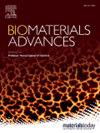Thiol-ene click chemistry: Enabling 3D printing of natural-based inks for biomedical applications
IF 5.5
2区 医学
Q2 MATERIALS SCIENCE, BIOMATERIALS
Materials Science & Engineering C-Materials for Biological Applications
Pub Date : 2024-11-05
DOI:10.1016/j.bioadv.2024.214105
引用次数: 0
Abstract
Over the last decade, 3D bioprinting has gained increasing popularity, being a technique capable of producing well-defined tissue-like structures. One of its most groundbreaking features is the ability to create personalized therapies tailored to the specific demands of individual patients. However, challenges including the selection of materials and crosslinking strategies, still need to be addressed to enhance ink characteristics and develop robust biomaterials. Herein, the authors showcase the potential of overcoming these challenges, focusing on the use of versatile, fast, and selective thiol-ene click chemistry to formulate inks for 3D bioprinting. The exploration of natural polymers, specifically proteins and polysaccharides, will be discussed and highlighted, outlining the advantages and disadvantages of this approach.
Leveraging advanced thiol-ene click chemistry and natural polymers in the development of 3D printable bioinks may face the current challenges and is envisioned to pave the way towards innovative and personalized biomaterials for biomedical applications.
巯基烯点击化学:实现用于生物医学应用的天然油墨 3D 打印。
在过去的十年中,三维生物打印技术越来越受到人们的青睐,因为这种技术能够制造出轮廓分明的类组织结构。其最具突破性的特点之一是能够根据患者的具体需求量身定制个性化疗法。然而,要增强墨水特性并开发出坚固的生物材料,仍需应对包括材料选择和交联策略在内的各种挑战。在本文中,作者展示了克服这些挑战的潜力,重点是利用多功能、快速和选择性的硫醇-烯点击化学来配制用于三维生物打印的墨水。作者将讨论和强调对天然聚合物(特别是蛋白质和多糖)的探索,并概述这种方法的优缺点。利用先进的巯基烯点击化学和天然聚合物来开发可三维打印的生物墨水可以应对当前的挑战,并有望为生物医学应用领域的创新和个性化生物材料铺平道路。
本文章由计算机程序翻译,如有差异,请以英文原文为准。
求助全文
约1分钟内获得全文
求助全文
来源期刊
CiteScore
17.80
自引率
0.00%
发文量
501
审稿时长
27 days
期刊介绍:
Biomaterials Advances, previously known as Materials Science and Engineering: C-Materials for Biological Applications (P-ISSN: 0928-4931, E-ISSN: 1873-0191). Includes topics at the interface of the biomedical sciences and materials engineering. These topics include:
• Bioinspired and biomimetic materials for medical applications
• Materials of biological origin for medical applications
• Materials for "active" medical applications
• Self-assembling and self-healing materials for medical applications
• "Smart" (i.e., stimulus-response) materials for medical applications
• Ceramic, metallic, polymeric, and composite materials for medical applications
• Materials for in vivo sensing
• Materials for in vivo imaging
• Materials for delivery of pharmacologic agents and vaccines
• Novel approaches for characterizing and modeling materials for medical applications
Manuscripts on biological topics without a materials science component, or manuscripts on materials science without biological applications, will not be considered for publication in Materials Science and Engineering C. New submissions are first assessed for language, scope and originality (plagiarism check) and can be desk rejected before review if they need English language improvements, are out of scope or present excessive duplication with published sources.
Biomaterials Advances sits within Elsevier''s biomaterials science portfolio alongside Biomaterials, Materials Today Bio and Biomaterials and Biosystems. As part of the broader Materials Today family, Biomaterials Advances offers authors rigorous peer review, rapid decisions, and high visibility. We look forward to receiving your submissions!

 求助内容:
求助内容: 应助结果提醒方式:
应助结果提醒方式:


